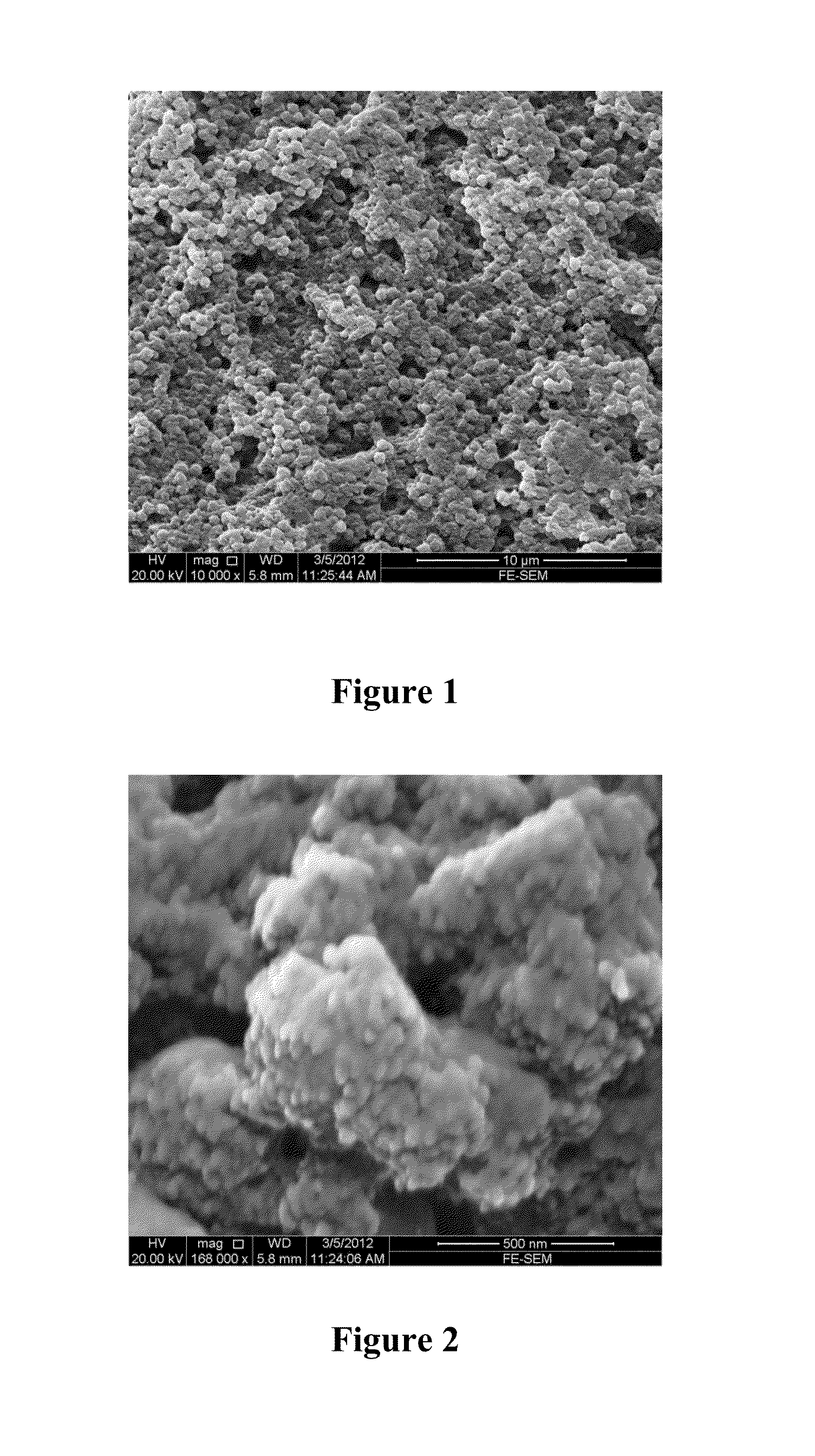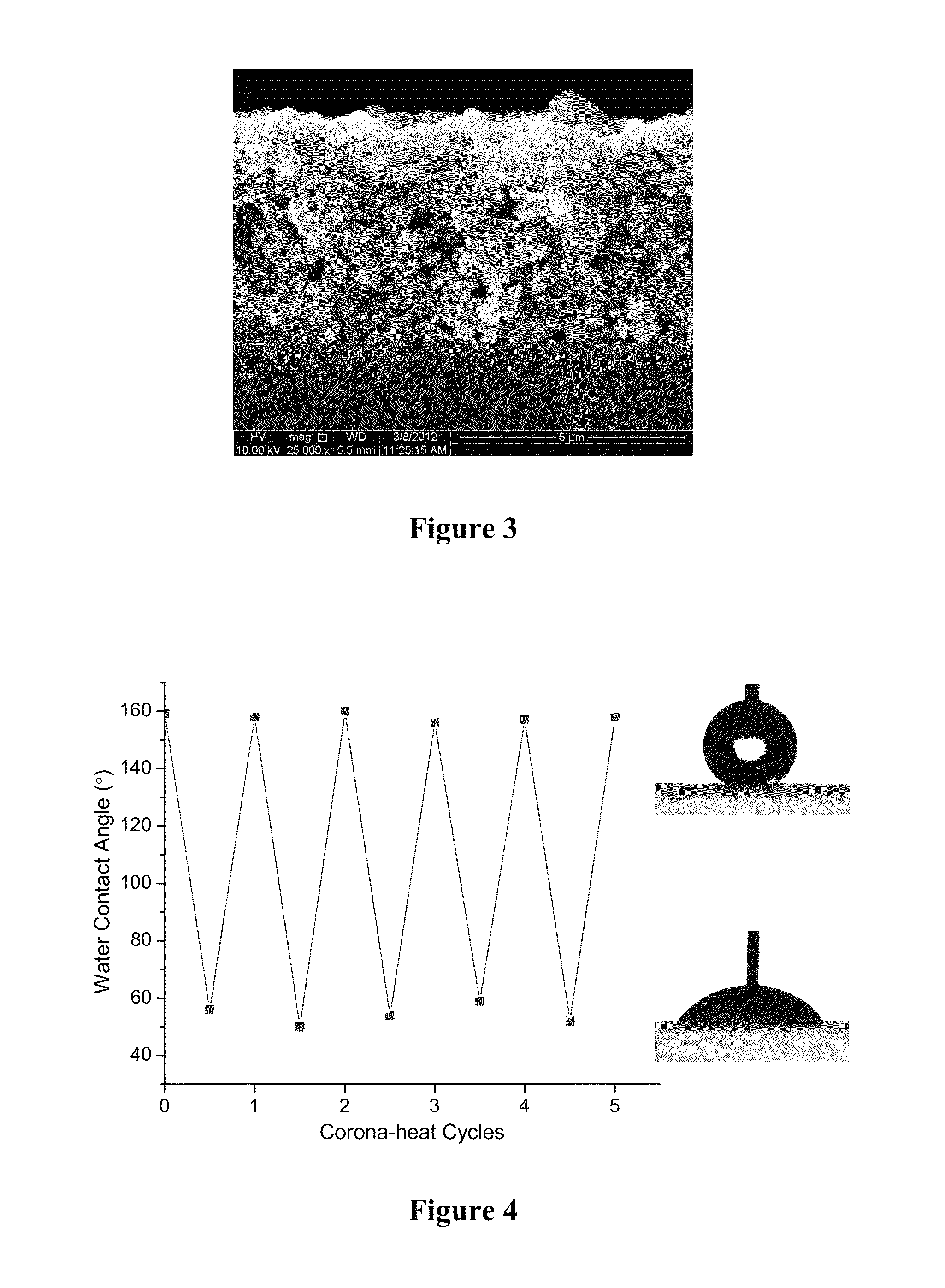Self-healing superhydrophobic coating composition and method of preparation
a superhydrophobic coating, self-healing technology, applied in soil conditioning compositions, other chemical processes, transportation and packaging, etc., can solve the problems of limited practical application of superhydrophobic surfaces, limited application range, and limited durability
- Summary
- Abstract
- Description
- Claims
- Application Information
AI Technical Summary
Benefits of technology
Problems solved by technology
Method used
Image
Examples
example 1
[0037]First, a precursor solution was synthesized using heptadecafluoro-1,1,2,2-tetrahydrodecyl-1-triethoxysilane (HFTEOS), i.e., compound (A) having a formula of C8F17—CH2—CH2—Si(OCH2CH3)3, and tetraethylorthosilicate (TEOS), i.e., compound (B) having a formula of Si(OCH2CH3)4, as the starting materials. The HFTEOS and TEOS were hydrolyzed by mixing with ethanol, water and hydrogen chloride with a molar ratio of HFTEOS:TEOS:C2H5OH:H2O:HCl=0.3:0.7:3.8:5:4.8×10−3 under vigorous stirring at 60° C. for 90 min. The precursor solution was then diluted to 10 wt % of solid content with isopropanol. 25 gram of the 10 wt % precursor solution was then mixed with 2 gram of Siltech TC11-9C (from Siltech Corporation, Canada), i.e., compound (C), a functionalized linear polydimethylsiloxane having about 50 dimethylsiloxane units, with three methoxy groups on each end. The solution was further mixed with 12.2 gram IPA-ST-UP (from Nissan Chemical America Corporation), an isopropanol dispersion of a...
example 2
[0039]The same procedure as described in Example 1 was repeated to prepare a coated glass slide. A wear test was done to demonstrate the mechanical stability of the superhydrophobic coating. In this test, a 100 g weight with a diameter of 2 cm was applied to a steel wool of #000 fine grade to scratch the coatings. The superhydrophobic coatings maintained its superhydrophobicity after 100 repeated passes with steel wool.
example 3
[0040]The same procedure as described in Example 1 was repeated to prepare a coated glass slide. The coating showed superhydrophobicity—water droplets rolled off easily on its surface. The following experiments were carried out to demonstrate the self-healing function of the coating. The freshly prepared coating was damaged artificially by a corona treatment under ambient laboratory conditions. After the corona treatment, the coating lost its superhydrophobicity. Instead of forming droplets, water spread and stuck to the surface. The damaged samples was then heated at 150° C. for 5 min, the superhydrophobicity was restored. Such a self-healing action remained when the sample went through multiple damage-and-heal cycles (see FIG. 4). The superhydrophobicity remained unchanged even after 5 cycles of corona-heat treatment. The self-healing could be performed repeatedly at lower heat treatment temperatures simply by increasing the treatment time.
PUM
| Property | Measurement | Unit |
|---|---|---|
| particle size | aaaaa | aaaaa |
| particle size | aaaaa | aaaaa |
| particle size | aaaaa | aaaaa |
Abstract
Description
Claims
Application Information
 Login to View More
Login to View More - R&D Engineer
- R&D Manager
- IP Professional
- Industry Leading Data Capabilities
- Powerful AI technology
- Patent DNA Extraction
Browse by: Latest US Patents, China's latest patents, Technical Efficacy Thesaurus, Application Domain, Technology Topic, Popular Technical Reports.
© 2024 PatSnap. All rights reserved.Legal|Privacy policy|Modern Slavery Act Transparency Statement|Sitemap|About US| Contact US: help@patsnap.com










